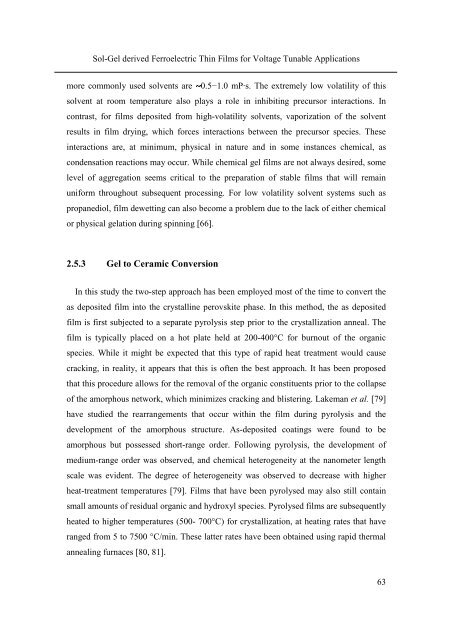PhD Thesis Arne Lüker final version V4 - Cranfield University
PhD Thesis Arne Lüker final version V4 - Cranfield University
PhD Thesis Arne Lüker final version V4 - Cranfield University
You also want an ePaper? Increase the reach of your titles
YUMPU automatically turns print PDFs into web optimized ePapers that Google loves.
Sol-Gel derived Ferroelectric Thin Films for Voltage Tunable Applications<br />
more commonly used solvents are 0.5−1.0 mP·s. The extremely low volatility of this<br />
solvent at room temperature also plays a role in inhibiting precursor interactions. In<br />
contrast, for films deposited from high-volatility solvents, vaporization of the solvent<br />
results in film drying, which forces interactions between the precursor species. These<br />
interactions are, at minimum, physical in nature and in some instances chemical, as<br />
condensation reactions may occur. While chemical gel films are not always desired, some<br />
level of aggregation seems critical to the preparation of stable films that will remain<br />
uniform throughout subsequent processing. For low volatility solvent systems such as<br />
propanediol, film dewetting can also become a problem due to the lack of either chemical<br />
or physical gelation during spinning [66].<br />
2.5.3 Gel to Ceramic Con<strong>version</strong><br />
In this study the two-step approach has been employed most of the time to convert the<br />
as deposited film into the crystalline perovskite phase. In this method, the as deposited<br />
film is first subjected to a separate pyrolysis step prior to the crystallization anneal. The<br />
film is typically placed on a hot plate held at 200-400°C for burnout of the organic<br />
species. While it might be expected that this type of rapid heat treatment would cause<br />
cracking, in reality, it appears that this is often the best approach. It has been proposed<br />
that this procedure allows for the removal of the organic constituents prior to the collapse<br />
of the amorphous network, which minimizes cracking and blistering. Lakeman et al. [79]<br />
have studied the rearrangements that occur within the film during pyrolysis and the<br />
development of the amorphous structure. As-deposited coatings were found to be<br />
amorphous but possessed short-range order. Following pyrolysis, the development of<br />
medium-range order was observed, and chemical heterogeneity at the nanometer length<br />
scale was evident. The degree of heterogeneity was observed to decrease with higher<br />
heat-treatment temperatures [79]. Films that have been pyrolysed may also still contain<br />
small amounts of residual organic and hydroxyl species. Pyrolysed films are subsequently<br />
heated to higher temperatures (500- 700°C) for crystallization, at heating rates that have<br />
ranged from 5 to 7500 °C/min. These latter rates have been obtained using rapid thermal<br />
annealing furnaces [80, 81].<br />
63

















